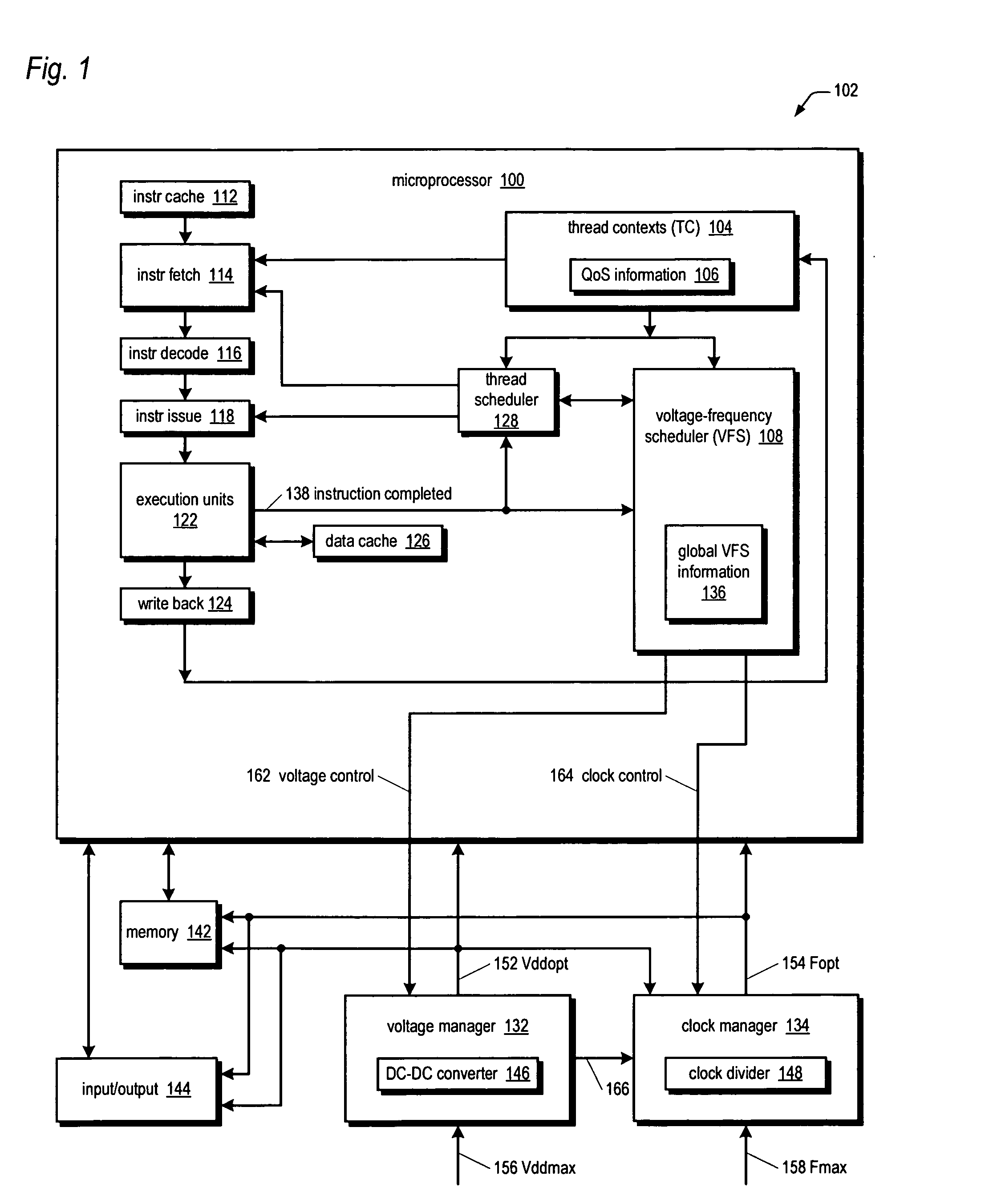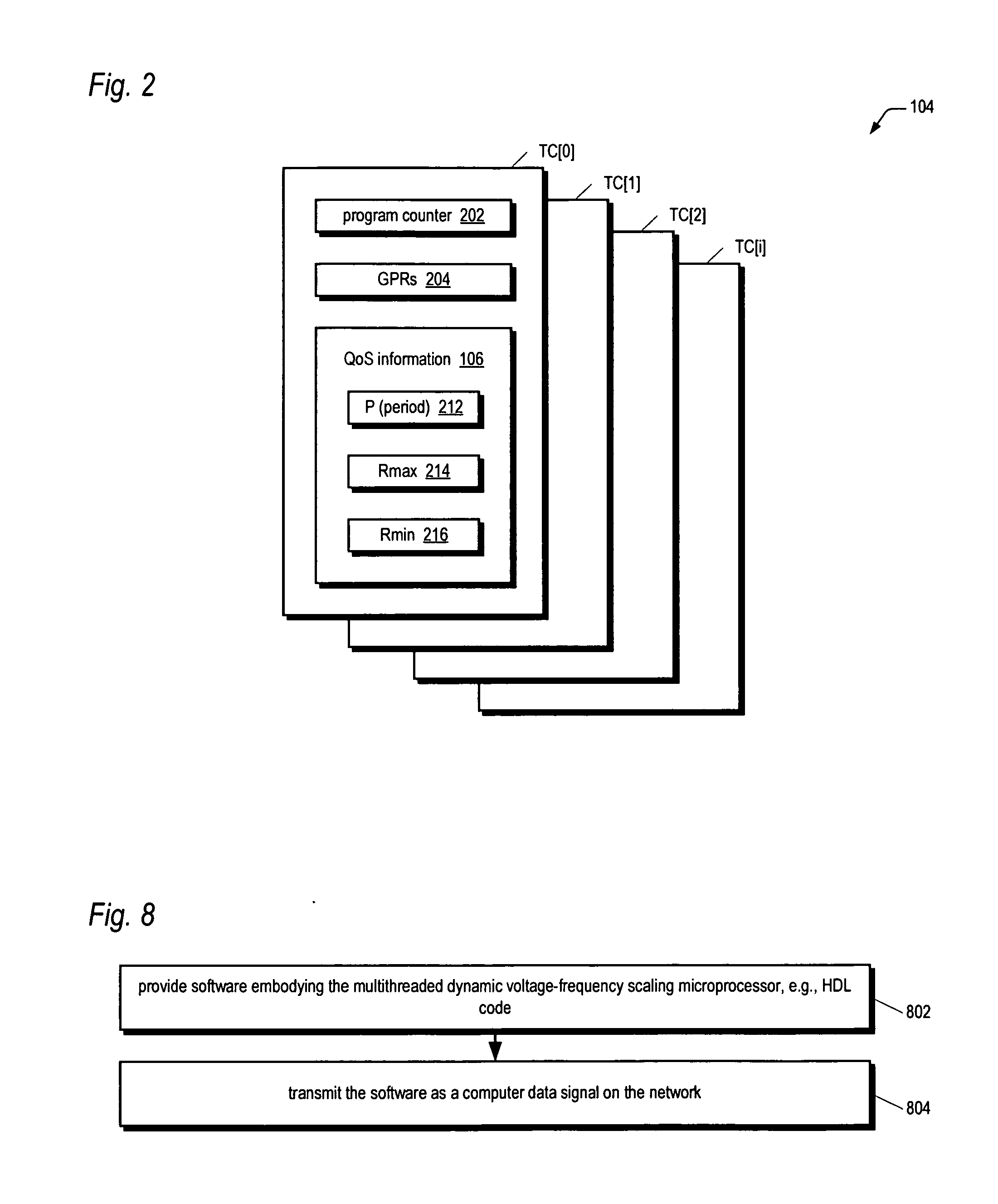Multithreaded dynamic voltage-frequency scaling microprocessor
- Summary
- Abstract
- Description
- Claims
- Application Information
AI Technical Summary
Benefits of technology
Problems solved by technology
Method used
Image
Examples
first embodiment
[0041] Referring now to FIG. 4, a flowchart illustrating operation of the system 102 of FIG. 1 according to the present invention is shown. Flow begins at block 402.
[0042] At block 402, system software programs the X value into the X register 302 of FIG. 3. Additionally, the voltage-frequency scheduler 108 initializes the Q register 312 with the value of X and initializes the N register 314 with the value of 1, since initially the system 102 is operating at the maximum clock frequency 158. Flow proceeds to block 404.
[0043] At block 404, when a thread starts up it provides its QoS parameters, which the system software programs into the appropriate QoS information registers 106 of the thread context 104 allocated for the new thread. In the embodiment of FIG. 4, the application associated with the new thread specifies the P and Rmax values, which the system software programs into the respective registers 212 and 214. Additionally, the system software programs the L register 334 of the...
second embodiment
[0058] Referring now to FIG. 5, a flowchart illustrating operation of the system 102 of FIG. 1 according to the present invention is shown. Many steps of FIG. 5 are similar to steps of FIG. 4. Like steps are numbered identically, and their description is not repeated for the sake of brevity. Differences between FIGS. 4 and 5 are now described.
[0059] In FIG. 5, block 504 replaces block 404 of FIG. 4. At block 504, in addition to the steps described above with respect to block 404, the thread also specifies an Rmin value in its QoS parameters, which the system software programs into the Rmin register 216 of FIG. 2 of the thread context 104 allocated for the new thread. In one embodiment, the applications optionally specify an Rmin 216 value. That is, a portion of the applications may specify an Rmin 216 value and a portion of the applications may not specify an Rmin 216 value, in which case the voltage-frequency scheduler 108 uses the Rmax 214 value at block 542 if the Rmin 216 value ...
third embodiment
[0064] Referring now to FIG. 6, a flowchart illustrating operation of the system 102 of FIG. 1 according to the present invention is shown. Many steps of FIG. 6 are similar to steps of FIGS. 4 and 5. Like steps are numbered identically, and their description is not repeated for the sake of brevity. Differences between FIG. 6 and FIGS. 4 and 5 are now described.
[0065] In FIG. 6, block 602 replaces block 402 of FIG. 5. At block 602, in addition to the steps described above with respect to block 402, system software programs the M value into the M register 304 of FIG. 3. Additionally, the voltage-frequency scheduler 108 initializes the C register 316, B register 318, and D register 322 with the value of zero.
[0066] In FIG. 6, flow proceeds from block 424 to block 626. At block 626, logic 338 increments the B register 318 value by one, increments the D register 322 value by C, and calculates the Ravg value and writes it into the Ravg register 324. The logic 338 calculates the Ravg valu...
PUM
 Login to View More
Login to View More Abstract
Description
Claims
Application Information
 Login to View More
Login to View More - R&D
- Intellectual Property
- Life Sciences
- Materials
- Tech Scout
- Unparalleled Data Quality
- Higher Quality Content
- 60% Fewer Hallucinations
Browse by: Latest US Patents, China's latest patents, Technical Efficacy Thesaurus, Application Domain, Technology Topic, Popular Technical Reports.
© 2025 PatSnap. All rights reserved.Legal|Privacy policy|Modern Slavery Act Transparency Statement|Sitemap|About US| Contact US: help@patsnap.com



